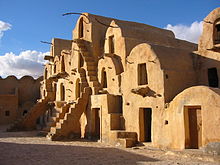Djeffara
Coordinates: 32 ° 36 ' N , 11 ° 42' E
The Djeffara (also Jifara or Al-Jfara , Arabic الجفارة, DMG al-Ǧifāra ) is an extensive plain that extends in a south-easterly direction for almost 400 km along the North African Mediterranean coast ( Little Syrte ). It extends roughly from the Tunisian city of Gabès to the area of the Libyan capital Tripoli and is between 30 and 180 km wide. A transition zone between desert steppe and coast, it is shielded in the west by the Djebel Dahar (Tunisia) from the dunes of the Great Eastern Erg and in the south by the Djebel Nafusah (Libya) from the rocky and scree desert of Hammada al-Hamra .
Coastal area
On the coast there are numerous shallow lagoons and the island of Djerba with many sandy beaches. Another special feature of the coastal areas are extensive salt lakes ( called Sebkhat ), such as Sebkhat Al-Melah , Sebkhat Bou Djemel and Sekbkat Al-Adhibat and Al-Martha , which extends up to 50 km inland.
climate
Although it has no flowing or permanent waters, the Djeffara plain is considered to be relatively fertile due to damming . The winters are quite mild, the temperatures during this period are 8–12 ° C at night and around 16–20 ° C during the day. On average, around 250 to 400 mm of precipitation fall each year, which corresponds to around 30–50 rainy days (November to March). The amount of rain decreases with increasing distance from the coast, and with it the fertility of the soil.
Summers are hot and very dry, with daytime temperatures of 30 to 35 ° C and peaks of up to 46 ° C when desert winds (in Libya the Ghibli or in Tunisia the Chehili ) hit the coast.
Agriculture
In the Tunisian Djeffara, olives and vegetables are mainly grown. The agricultural products are intended both for personal use and for export. On the Libyan side you can find citrus fruit plantations, but also olive groves.
In some areas, dates are also grown, for example in Gabès or in some places on the edge of the Djebel Nafusah. Since the surrounding areas are rather hostile and extremely barren, the Djeffara is of great agricultural importance.
tourism
Apart from that, the Djeffara also has tourist attractions. In the Djeffara there are a number of forts and ruins, some of them well preserved, for example in Naoura , Sidi Ahmed Chaouch , Ras Jedir , Henchir Al-Diab and Henchir Al-Menafaa .
In the southern Tunisian Djeffara you can visit Ksour , the famous Berber warehouse castles , z. B. in Bir Beni Mahira, Ouled Aoun, Ksar Morra or Ksar Retbet Al-Krachaoua. There are also Roman excavations in Gigthis .
In Libya, the lie UNESCO for World Heritage appointed excavations of Sabratha .
See also
- Al-Jifara , municipality in the heartland of the plain


